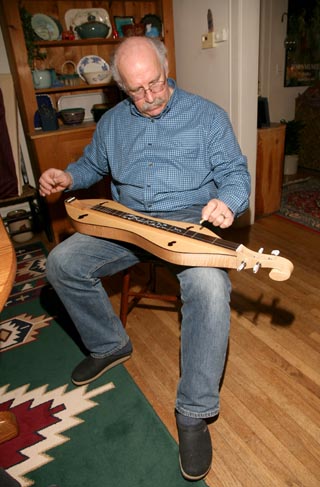
While Nils Caspersson may not have had music running through his veins when he was born, he certainly picked up a love for listening to, researching and building musical instruments - specifically, the dulcimer. It is a hobby that began in 1969 when he was a student at SUNY Fredonia and has lasted for close to 40 years. Caspersson’s father and his father’s parents moved to the United States in the 1930s. His father was an engineer and his grandfather was an engineer and a mathematician. “They weren’t musical at all, but when they came here they settled in the Adirondacks, near Saratoga Springs and as a result I grew up close to a performing arts center,” he said. “When I was a kid I would hitchhike to the center to hear the music.” He was involved in music all through high school and played guitar but says he really doesn’t remember the exact moment he first heard the dulcimer. Once he did he was hooked. His first opportunity to build one was in college. “I met a professor who made musical instruments, including the dulcimer. He knew about crafting them but not much about music or tuning - I knew about that so we started working together.” A retired language arts teacher from Hilton, Caspersson and his wife, Vicki, and children traveled to many folk festivals when the children were younger. “We loved being part of the folk music festivals,” he said. “Folk music is really about us, the people, it is about music that the average person can play. The dulcimer is like that.” According to Caspersson, whether a person is five- or 85-years-old, with a little bid of time - sometimes less than five minutes - they can learn to play a tune on the fretted dulcimer. “With a bit of practice you can really be off and running,” he said. Caspersson, who has a wealth of knowledge of Sweden, its history, mythology and the locales in which he still has family and from which his father came, said he became intrigued with the history of the dulcimer and that led to him diving into research on its origins. A grant from the Arts and Cultural Council for Greater Rochester will allow Caspersson and his wife to take a trip to Sweden where they will stay in the family cabin and attend the “mid-sommar,” a holiday held in Scandinavia when musicians will gather to celebrate summer. Upon his return home, as part of the grant requirements, he will apply his research to an interactive performance program related to the origins of the dulcimer. Caspersson has a website in progress at www.orleansdulcimers.com which will update the progress on his program and announce when he will be offering it. April 8, 2007 |
